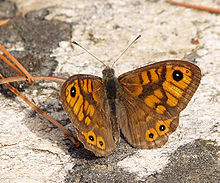Wall fox
| Wall fox | ||||||||||||
|---|---|---|---|---|---|---|---|---|---|---|---|---|

Wall fox ( Lasiommata megera ) female |
||||||||||||
| Systematics | ||||||||||||
|
||||||||||||
| Scientific name | ||||||||||||
| Lasiommata megera | ||||||||||||
| ( Linnaeus , 1767) |
The wall fox ( Lasiommata megera ) is a butterfly ( butterfly ) from the noble butterfly family (Nymphalidae).
features
The wall fox has a wingspan of 40 to 52 millimeters. The upper sides of the wings are orange-brown and have a dark brown grid-like pattern. The females are usually a little lighter in color. On the forewing, near the wing tip, there is a white-core black eye-spot. In the male there is a clearly visible scented scent in the discal region . On the upper side of the hind wings in the post-disk region in cells 1c, 2, 3 and 4 there are small white nucleated black eye spots. The underside of the forewings is orange-brown and also has a black eye-spot with white cores. On the light brown-gray hind wings in cells 1c - 6 there are brown eye spots with black borders and white nuclei.
Similar species
- Great ox-eye ( Maniola jurtina )
- Brown eye ( Lasiommata maera )
- Lasiommata paramegaera
- Forest board game ( Pararge aegeria )
Flight time
Two, in warm regions up to four generations from late March to early November.
habitat
The habitat of Lasiommata megera is variable. These include grassy rocky slopes and gorges, meadows rich in flowers and forest clearings. The moths often occur on stony or gravelly ground. The habitat is usually warm and dry.
Way of life
The females lay the eggs individually near the ground in edge structures on grasses. Host plants are grasses such as real sheep fescue ( Festuca ovina ) and pinnate twinkles ( Brachypodium pinnatum ). The moth prefers red to blue-violet flowers. The young caterpillars have a striking brown dotted head. The older caterpillars have a green head, the body has a green base color with light vertical stripes. The older caterpillars are nocturnal. Pupation into the fall pupa takes place close to the ground on grasses.
distribution
From North Africa and Western Europe through Russia and Western Asia to Western Siberia , Syria , Iran and Tianshan . The moth is also found in Ireland and the Mediterranean islands. The vertical distribution ranges from sea level to 2000 meters in the mountains.
swell
literature
- Tom Tolman, Richard Lewington: The butterflies of Europe and Northwest Africa . Franckh-Kosmos, Stuttgart 1998, ISBN 3-440-07573-7 .
- Hans-Josef Weidemann: Butterflies: observe, determine . Naturbuch-Verlag, Augsburg 1995, ISBN 3-89440-115-X .
- Günter Ebert, Erwin Rennwald (ed.): The butterflies of Baden-Württemberg . 1st edition. tape 1 . Butterflies . 1. General part: systematics, taxonomy and nomenclature, faunistics and ecology, endangerment and protection, data processing; Special part: Papilionidae, Pieridae, Nymphalidae . Ulmer, Stuttgart 1991, ISBN 3-8001-3451-9 .
Individual evidence
- ↑ a b W. Düring: Mauerfuchs. In: Butterfly in Rhineland-Palatinate. BUND RLP, November 22, 2019, accessed on April 17, 2020 (German).

